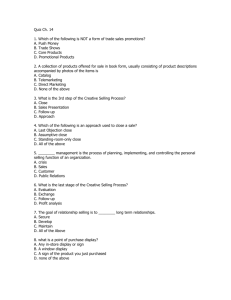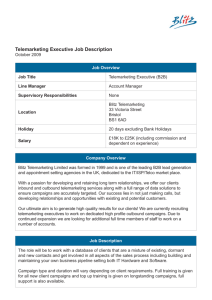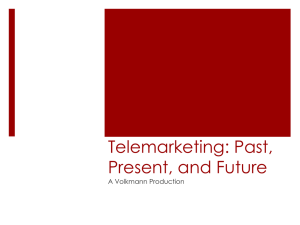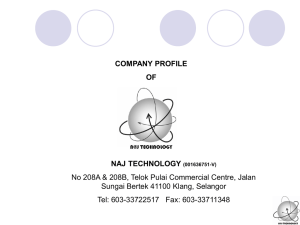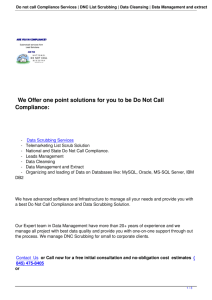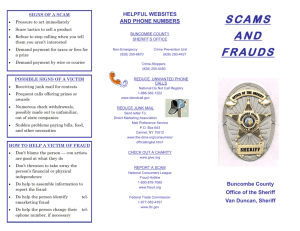Telephone communication
advertisement
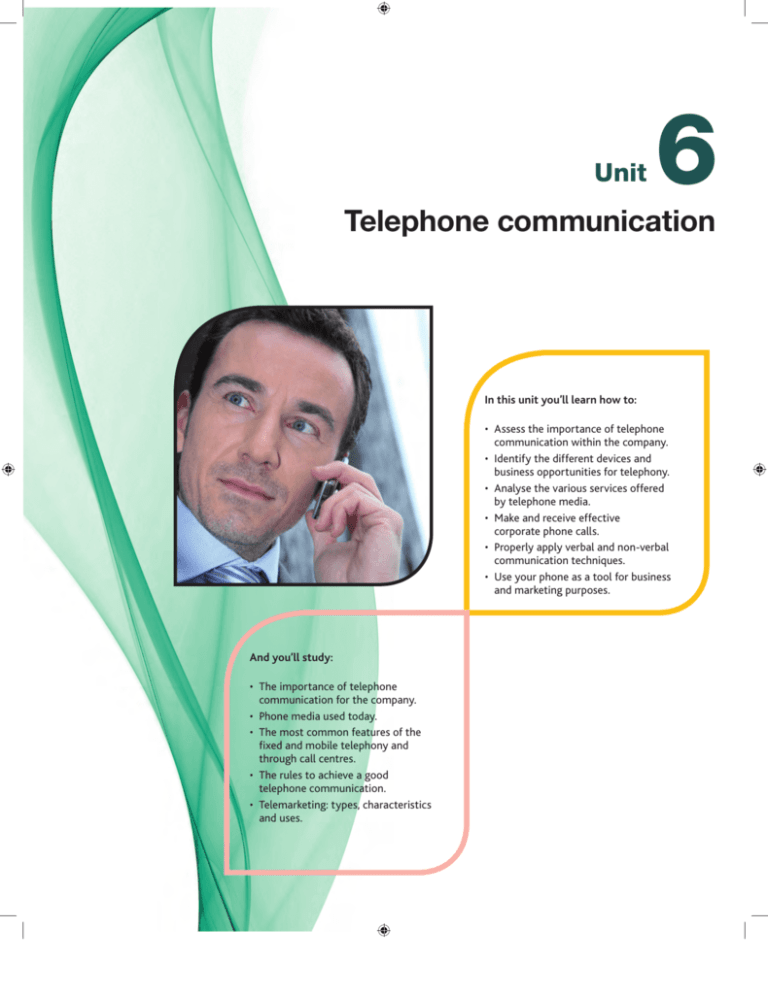
Unit 6 Telephone communication In this unit you’ll learn how to: • Assess the importance of telephone communication within the company. • Identify the different devices and business opportunities for telephony. • Analyse the various services offered by telephone media. • Make and receive effective corporate phone calls. • Properly apply verbal and non-verbal communication techniques. • Use your phone as a tool for business and marketing purposes. And you’ll study: • The importance of telephone communication for the company. • Phone media used today. • The most common features of the fixed and mobile telephony and through call centres. • The rules to achieve a good telephone communication. • Telemarketing: types, characteristics and uses. 6 Telephone communication 1. Telephone communication Do you know that...? Alexander Graham Bell (18471922)wasborninEdinburgh(Scotland).Hewasraisedinafamilyof speechtherapists.Bothhisgrandfather and his father were specialists in this field, and he also decided to continue the family traditiontoteachpeopletospeak properly. Throughout his life, he became interested in improving education systems for the deaf, so his main activity was aimed at studying thelearningsystemforthosewith hearingimpairments. In1873hewasappointedprofessorofVocalPhysiologyatBoston University.Inadditiontohisteachingtasks,Bellstudiedhowtodesign an electromagnetic device that could convert electrical impulses into sound. Initially, his idea was tobuildadevicethatwascapable of imitating the human voice and reproducing vowels and consonants.In1878heopenedthefirst telephoneexchangeinNewHaven (Connecticut), United States, and in 1884, the first long-distance communication within the country from Boston (Massachusetts) toNewYorkwasmade. Telephonecommunicationisone of the most important forms of communication within the company. Although today its use is being replaced by other forms of communication (suchasemail),phoneuseisoneofthemostcommonmeansbywhichtomaterializeboth internal and external communications. Itisveryimportantinbusinessbecauseitisthemediumthroughwhichthefirst contact with,orfromthecompanyismade.So,beforeanypersonalcontact,theusualthingistomake aphonecalltoarrangeaninterviewortospecifyanymatterortopic.Theinterlocutoratthe otherendofthelinewillformanideaaboutthecompanydependingontheimpressionafter thisfirsttelephonecontact. Inanycase,beyondthebusinesssector,itisalsocrucialtofollowapropertechniquewhen havingtelephoneconversations,asitisanessentialtooltoachieveourgoalsinaphonecall, eitherasitssendersoritsrecipients. Fromthestandpointofbusinesscommunication,telephoneusehasanenormousadvantage: interlocutors don’t see each other, and this may work for solving tricky or unfavourable situations.Asinterlocutorsdon’tseeeachother,theargumentsprovidedinatelephoneconversationmaybemoresolidandcredibleifweapplythepropertechniquesandprocedures. Anotheradvantageofthistypeofcommunicationisthatwecandootherthingsaswespeak, suchastakingnotes,searchforsomethingonthecomputer,asksomethingtoaworkmate (alwayswithdiscretion),andsoon. Thus,wemaysaythatapplyingtheappropriatetelephonetechniquesisessentialtogetthe mostoutofthiscommunicationtoolinbusiness. Thankstoadvancesintechnology,telephonecommunicationdeviceshaveevolvedgeneratingnewservicesandexpandingitscapabilities. Case study 1. Who invented the telephone? AlexanderGrahamBell(1847-1922)hasbeentraditionallyregardedastheinventorofthe telephone.However,bothAntonioMeucciandElishaGrayclaimedthattheywerealso theauthorsofthisinvention.Whatcanyousay?Findinformationonlineaboutthethree ofthem(forexample,www.asinorum.com/meucci-bell-y-gray/407orwww.xatakaciencia. com/telecomunicaciones/7-de-marzo-graham-bell-se-lleva-el-gato-al-agua). Solution: Fromtheinformationintheselinks,itseemsthattheinventorofthefirstvoice-transmissiondevicewastheItalianMeucci;however,hecouldn’tinscribethepatentofhistelettrofonobecauseofseveraleconomicandbureaucraticreasons.BothGrahamBelland GrayinscribedonFebruary14,1876twoseparateinventionsthatwereessentiallythe sameinthepatentoffice,buttheformergotpriorityintheprocess(apparentlybecause ofhiscontactsintheoffice).Butin2002,theCongressoftheUnitedStatesofAmerica alsorecognizedMeucci’sinvention. Activities 1. Today, there are several phone companies operating in Spain,butdoyouknowwhichcompanyhadthemonopolyonphoneserviceinourcountry?Whendiditbegin operatinginSpain? 2. Customerphonesusuallystartwiththeprefixes900,901 or902.Whatarethedifferencesamongtheseprefixes? 112 3. Do you know how many users of mobile telephony are thereinSpain?Aretheymanyorjustafewregardingthe populationinourcountry?Checktheselinksforfurther information: http://www.ontsi.red.es/ontsi/es/indicador/ evolucion-del-numero-de-clientes-de-telefonia-movil-enespanaandwww.ine.es. Telephone communication 6 2. Telephone media and equipment Almosteverybodyhasaphonetoday(mobile,mostly).Thisdeviceiswidespreadamongthe populationand,aswestatedabove,isoneofthemostimportantcommunicationtoolsin thefieldofbusiness. Atthepresenttime,moreandmorecompaniesareusingtelephonesystemstoprovidetheir businessservices. Thevariousdevicesusedintelephonyareusuallygroupedintothreetypes: • Fixedindividualdevices. • Privatebranchexchanges(PBX). • Mobiledevices. Wewillknowmoreaboutthesedevicesinthefollowingsections. 2.1. Fixed telephony devices Thesedevicesareknownasfixed telephones.Theyarenon-portabledevicesthatconnect tootherphonesortoatelephoneexchangethroughanetworkofconductivemetals(copper networks,althoughtodaythesearebeingreplacedbyopticalfibernetworks). Vocabulary • Optical fiber. Transmissionmediumthatisoftenusedintelecommunications, consisting of averythinfiber(ithasthethickness of a human hair) that is made of transparent material, glass or plastics. It sends light pulses that represent data to betransmitted.Thelightsource maybelaserorLED.Compared to copper networks, it is much cheaper (the raw material is sand), but it has the disadvantageofitsfragilityanddifficulty tobewelded. • Laser. Beam with a single wavelength(monochromatic),andthereforewithasinglecolour. • LED.Light-emittingdiode. • Diode. Electroniccomponentthat allowsanelectriccurrenttopass inonlyonedirection. 2.2. PBX Aprivate branch exchange or PBXistheequipmentthatconnectscallsbetweentwo destinationsorends. • IP. It corresponds to the acronym for Internet Protocol. This system allows sending and receivingdataovertheInternet. They are located in places or locations that hold all the equipment that plays the role of connecting two different geographical points. Telecommunication companies manage the equipmentandprovideservicestobothbusinessandindividuals. Basically,PBXsaresmalltelephoneexchangesthatareinstalledintheofficesofacompany; theirbasicfunctionsarecalltransferamongextensions,callerID,conferencecalls,callwaiting andvoicemail,amongothers,accordingtotheneedsofthecompany. Whiletheymaybeanalogueordigital,digitalPBXstodayhavevirtuallyreplacedtheanalogue devices. Furthermore, the development of services through the Internet has changed the classical conceptofPBX,whichhasbeenreplacedbyIPPBXs. A. IP PBXs Watch out! Also known as VoIP phone systems, these comprehensive telephone systems provide telephone calls over IP data networks (Fig.6.1). An IP PBX is configured to send all calls usingdatapacketsthroughadata network (Internet), rather than through traditional telephonenetwork.Asweindicatedabove, companies are now replacing their traditionalsystemsforIPPBXsbecauseoftheir manyadvantages. We must differentiate between the concepts of Voice over IP (VoIP)andIPtelephony. • VoIP is a set of standards, protocols,devicesandtechnologies forthedeliveryofvoiceoverthe IPprotocol. • IP Network isthepubliclyavailable telephone service with VoIPtechnology. Fig. 6.1. IPPBXmodel. 113 6 Telephone communication PBXs also have telephone terminals or IP telephone terminals; the latter devices allow communication using an IP network, either through a local area network or through the Internet.Althoughtheylooklikearegulartelephone,thisisactuallyahardwarethatusesa datanetworkconnectioninsteadofatelephonenetworkconnection. IPphonesoftenhavemoreoptionsandadvantagesthanaconventionaltelephone.Asthis system is fully digital and programmable, those terminals usually have special keys; some includeavideocameratomakevideoconferences.Thepriceofthesedevicesisusuallythe sameastraditionalphones. B. Call centres A call centre is a tool aimed at communicating with customers who use the phone asaprimarydevice. Callcentres(Fig.6.2)managebothincomingcalls(inbound)andoutgoingcalls(outbound). Today,mostcallcentresaremanagedwithIPPBXsbecausethecostismuchlowerthanwith traditionalPBXs,andalsoofferagreatervarietyofservices. C. Contact centres Fig. 6.2. Callcentre. Contact centres are an evolution of call centres aimed at managing a large volume ofphonecalls,bothincomingandoutgoingcalls. Theycanalsomanagetherelationshipwithcustomersthroughothermediasuchasfax,chat ormessagingsystems,bothSMSandmultimedia. Case study 2. Free registration in IP telephony software InternetprovidesuserswithIPtelephonysoftwarethatallowsthemtocallorreceive callsatnoextracostonthepriceoftheirInternetconnection.Oneofthebestknownis Skype,whichisveryeasytoinstallandconfigure. Inthiscasestudywewilldownloadandconfigureitwiththefollowingparameters: AccountnamewithSkype. • User. • Password. • E-mail. • AddacontacttoyourSkypeaccount. Solution: CreatinganaccountwithSkypeisveryeasy.Thestepsarethefollowing: • Downloadtheprogramfromtheweb:http://www.skype.com • Clickonthefilesetup.exe • Followtheinstallationsteps.Wemustenter:accountname,usernameandpassword (acombinationoflettersandnumbers). Iftheuserisavailable,ourSkypeaccountisreadytobeused. Activities 4. SearchtheInternetforsomeVoIPserviceprovidersandwritedownthenameof threeofthematleast. 5. ListthreeSpanishcompaniesthathaveacallcentre,andthreewithacontactcentre. 114 Telephone communication 6 2.3. Mobile devices Mobilephoneshaveundoubtedlymeantoneofthe great revolutionsofthetwentiethcentury,asithasprovidedcommunicationsandmobilityasnodeviceeverdidbefore.Ithasbeen sosuccessfulthatinsomecountrieslikeSpain,recentstudiesindicatethatthenumberof mobilephonedevicesfarexceedsthenumberofinhabitants. Amobile phoneisaportabledevice(wireless)thatallowsaccesstothemobilephone networkingeographicareaswheretheserviceproviderhascoverage. Apartfrommakingandreceivingphonecalls,therearemanyandvariedfunctionsthatcan beperformedtodaythroughamobiledevice:makingpaymentsandbalancinginquiriesfrom bankaccounts,connectingtotheInternet,sendingandreceivingemails,recordingvideos,takingqualitypicturesandrunningmanyotherapplications,dependingonthephonewehave. Themobileterminalsarenowgroupedintotwo typesofdevices:PDAsandSmartphones: • PDA. It is virtually a small computer (Fig. 6.4). The acronym goes for Personal DigitalAssistant.TheyallowustobrowsetheInternetandcheckouremailatanytimeand anywhere. • Smartphone.Imagineamobilephonewithfurtherfunctionssuchaspicturesandvideos, radio, MP3 player or television: this is a Smartphone (Fig. 6.5). The fundamental reason whythesedeviceshavearisenistotrytomakeiteasierforbusinessmanagementoverthe phone. Fig. 6.3. Thefirstmobilephone.Itisthe MotorolaDynaTAC8000X.Itwenton salein1983atapriceof$3,995.Ithad aweightof0.79kganditsbatterytook tenhourstocharge.Foritsdevelopment, Motorolainvestedonehundredmillion dollarsanditsresearchlastedalmost fifteenyears. Thefirstso-calledSmartphonewasdevelopedbythecompanyIBMin1992andwascalled SIMON. Its features were very limited (send and receive calls, calendar, address book, and sendandreceivefaxes),especiallycomparedtocurrentdevices. ThemainservicesthataSmartphonemayprovideare: • Internet,whateveroursituation(work,home,etc.). • E-mail. • Filetransmission,mostlyimages. • Videoconference. • Digitalcamera(forvideorecordingandphotography). Fig. 6.4. PDAmodel. • Audioandvideoqualityplayer. • Electronicpersonalagenda. • GPS(geographicallocationmapsofgreataccuracy). • Ownoperatingsystem. Activities 6. Youprobablyhaveapersonalmobilephone.Makeashortlistwiththemainfeatures ofyourterminal. 7. SearchtheInternettofindoutthereasonwhymobiledevicesalwayshaveEnglish names. 8. Doyouknowthemeaningofthefollowingiconsdisplayedonamobileterminal? Fig. 6.5. Smartphonemodel. Watch out! For some of the mentioned services, first we must hire or apply forthemtoourtelephoneservice provider. 115 6 Telephone communication 3. Additional services offered by the telephone equipment Theservicesthattelephonyequipmentcanofferarevaried,andavailabilitydependsonour supplieroftheseservices.Inmostcases,theseservicesimplyanextracharge. Supplementaryservicesmaybegroupedinto: Fixedtelephony Commonfeatures PBX Mobiletelephony Supplementary services of telephone equipment Billing-relatedservices Business-relatedservices Scheme 6.1. Additionalservicesoftelephoneequipment. 3.1. Common features Therearecertainfeaturesthatarecommonwithineachtypeofservice.Wewillstudythem inthefollowingsections. A. Fixed telephony Thesearethecommonfeaturesoffixedtelephony: Notice of charge Itallowstheusertoreceiveinformationonthecostofacallduringand/orattheendofit. Call forwarding Itdivertsincomingcallstoanyphonenumberthathasbeenpreviouslychosen. Call hold Itkeepsacallonholdtoattendanotherincomingcallandretrievesitagain. Call waiting Itnotifiesanincomingcalltothesubscriberwhiletalking,sothatthesubscribermayreject,accept orignorethatcall. Call offer Itdisplaystheincomingcallonthescreenandallowstherecipienttoacceptorrejectit. Identification of the calling line Itidentifiestheincomingcallnumbers. Three-way calling Threepeoplecantalksimultaneously. Completion of calls Incaseoffailuretoansweracall,orwhentheuserisbusy,thecallisfinished. Call transfer Itenablesausertoconnecttwoincomingcalls. Notice of initiation of multiconference Itallowsacommunicationwithmorethanonerecipientatatime. Recall Itmakesacalltothelastdialednumber,evenseveraltimes. Table 6.1. Typicalservicesoffixedtelephony. Activities 9. TheservicesinTable6.1arenottheonlyones.Searchthe webandexplainthesetwosupplementaryservices: 116 a) Donotdisturb. b) Multiplesubscriber. Telephone communication 6 B. PBXs InthecaseofPBXs,themostcommonsupplementary featuresare: • Identification of incoming calls. • Call restrictions. Itlimitsthenumberofcallsmadetotheoutside. • Music on hold.Throughthisservice,theuserhearsamusicaltunechosenbythecompany untiltheoperatorortheappropriatetelephoneextensionanswersthatcall. • Billing information. Throughthisfeatureweareinformedaboutthecostofaservice. In addition to these features, there are others that are specific for IP PBXs, including the following: • Calltransfer,bothinternalandexternal. • Callforwardingwhenthelineisbusyorthecallisnotanswered. • Donotdisturb. • Remoteextensionsoutofoffice(fortelecommutersoremployeesofotheroffices). • Callgroups. • Remotecallcapture. • Voicemail(general,individualandgroup)protectedbypassword. • E-mail. Do you know that...? Telecommuting or telework is a methodthatallowsdistancework. Today,moreandmorecompanies take advantage of the benefits thatthissystemhasforemployees andforthecompany. • Managementofblacklists(phonenumberswithforbiddenaccess). • Actionstobetakenaccordingtodatesandtimes(workinghours,holidays,etc.). • Conferencerooms(twoormoreterminalssimultaneously). • Listofincomingandoutgoingcalls,withconsumptiongraphics. • Automaticdetectionofincomingfaxes. • Queuingofincomingcalls(functionforcallcentres). • Recordingofincomingandoutgoingcalls(functionforcallcentres). • Videoconferencing,whichallowstocarryoutconversationsandseetwoormorepeople locatedindifferentgeographicalareasovertheInternet. C. Mobile telephony The features that mobile terminals can offer will depend on the specific model and the service provider (telephonecompany).Themostcommonare: • Length of calls:bothincomingandoutgoing. • Voice mail: ifacallisnotanswered,amailboxwillcollectthemessages. • Call forwarding. • Call waiting. • Missed calls: ifourphoneisoff,outofcoverageorbusy,thisfeaturewillnotifyusthe incomingcallsthatwehavereceivedbuthaven’tanswered.Thisnoticeisusuallycarried outviaSMS. • Address book: theterminalcanstorethephonenumbersofyourcontacts.Eachcontact typicallyincludesseveraltypesofphonenumbers(main,work,home,etc.),aswellasother data,suchasemailorwebpage. • Conference calling:itallowshavingconversationswithseveralpeopleatonce. • Emergency call: it can communicate with an emergency telephone number, 112 (for Europe),regardlessofthemodeinwhichthephoneis. 117 6 Telephone communication Vocabulary • Voice recognition: it allows you to call a user number using your voice without typing orselectingthenumber. • Bluetooth.Communicationtool thatallowsvoiceanddatatransmissionviaradio. • Infrared: it allows data transmission between devices. Now it is being replaced by the Bluetoothsystem. • WI-FI. The term was coined by the"Wi-FiAlliance".Itisasetof standardsforwirelessnetworks. Itworkswithradiowaves. • GPRS:thistechnologyallowsaccesstovariousservicessuchasuserlocation,routesand mapschecking,onlineshopping,etc. • WAP. Protocol that uses wirelessnetworks(suchasaccessing the Internet through a mobile phone). It means "Wireless ApplicationProtocol". • UMTS. Itmeans"UniversalMobile Telecommunications System". It replaces the old GSM andisusedin3G(thirdgeneration)terminals. • 3G.Abbreviationforthirdgeneration. Services related to third generationterminalsprovidethe abilitytotransfervoce,dataand non-voice data (such as downloading programs, exchanging emailandinstantmessaging). • Protocol. Set of rules that are established for two devices to communicatewitheachother. • SMS messages: service that allows you to send short messages. Each message is often between160and200characters. • Multimedia messaging or MMS: it allows you to send messages with pictures, videos, voicefiles,songs,etc. • Video calling: youcanseeyourinterlocutorinyourterminalscreenasyouspeak. • Downloads: youcanperformlegaldownloadsofmusic,videos,programs,andsoon. • Email: youcansendandreceivee-mailsonyourterminal,butfirstyoumustconfigureyour mobilephonetodoso. • Internet services: youcanaccessthewebviaamodemorWi-Finetworks. • GPS navigation:itallowsyoutouseyourterminalasanavigationsystem,forexample, whendrivingincitiesthatyoudon’tknow. 3.2. Billing-related services Both fixed and mobile telephony have billing-related services. Depending on the service provider,theymaybeofferedforfreeorinvolveextracosts. Theseservicescanbegroupedintothreetypes: • Information on bills: itisthesetofdatathatappearsonyourbill,suchastheuser,phone numbersthatyoucall,durationandcostsofeverycall,discountplans,andsoon. • Consumption control: ifrequested,thisservicesendsanalerttotheuserwhenaspecific billinglimithasbeenexceeded. • Flat fee:itmeansthatwepayafixedamountinthebillingperiod,regardlessoftheamount and duration of calls. It is usually applied to fixed telephony users, but currently it is expandingtomobiletelephony. 3.3. Business-related services Whentalkingabouttelephonyservicesrelatedtobusiness(apartfromwhathasbeenalready discussedinprevioussections),wemustrefertothesetofrelationshipswithsuppliers,employeesandcustomers.Thus,inthecorporatebusinessworldtherearetwoimportantconcepts: • M-Business (Mobile Business Development): itistheuseoftechnologyandapplications that enables business processes using mobile devices. It includes a number of activities ranging from communications via e-mail to receiving product information via SMS or orderingthroughthephone.M-businessincludesthefollowingbusinesstypes: – B2B (Business to Business): applicationsorientedtothesaleofgoodsandservices.For example, it happens between a company and one of its customers (which, in turn, is anothercompany). – B2C(Business to Consumer):theprocessthatoccursbetweenacompanyandaconsumer. For example, it happens between a company and a person buying something throughamobilephone. 118 Telephone communication 6 – B2E(Business to Employee): setofactivitiesaimedatprovidingproductsorservicesto acompany’sownemployees. – B2G (Business to Government): itisfocusedonbusinessactivitiesbetweenbusiness andgovernments(eitherlocally,regionallyornationallyandeveninternationally). • M-Commerce (Mobile Commerce): this concept includes any transaction carried out throughatelecommunicationsnetwork(suchasthosemadethroughamobilephoneor throughPBXs).BuyingamovieticketusingthemobilephoneisanM-Commercesituation. Inturn,therearethreetypesofservicewithinM-Commerce: – Mobile-ticketing: acustomercanorder,payfor,obtainandconfirmticketsfromanywhereandanytimewithamobiledevice. – Mobile-banking:itistheuseofmobiledevicesfortransactions,paymentsoranyother kindofoperationwithafinancialinstitution.ItisperformedviaSMSoronline. – Mobile payments:itisthechargetocustomersthroughmobiledevices. Case study 3. Services through mobile phone Weneedtomakeatelephoneappointmentatahealthcareservice,whichisprovided throughacallcentre. Let’sseewhatkindofservicesareproducedwhenwecallfromamobilephoneand: a) Wecalla902numberandweareinformedaboutitscost. b) Theyinviteustochooseanextension(suchaswhenwehear:"Forconsultations, pleasepress1;foroutpatients,pleasepress2;otherwise,pleaseholdtheline"). Atuneplayswhilewewait. c) Anoperatortellsusthattheconversationwillberecordedforsecurityreasons. d) Wearetoldthatthedateandtimeoftheappointmentwillbesenttousviaatext message(SMS)toourmobilephone. Solution: Thetypesofservicesthatwehavebeenofferedare: a) Calltoapremium-ratephonenumber(informationoncosts). b) Calltransferwithmusiconhold. c) Queuingforincomingcallsandrecordingofincomingcalls. d) SMSmessageservice. Activities 10. Indicatewhattypeofbusinessisoccurringineachofthefollowingcases: a) AcarcompanysendsanSMSaboutanewcarmodel. b) AbankoffersinsuranceforaclientcompanythroughanMMS. 11. Imagineyouhaveamobileterminalandyoureceivethefollowingmessages: a) "SudineroBankinformsyouthatachargeof¤150hasbeenmadeonyourcard 4546.XXXX.XXXX.8796 on 12.12.2012. Concept: purchase made on Amazon. Moreinfo:909.11.22.33". b) "Entradasdirectas.com:confirmationisrequestedforpurchaseson12.12.2012at 19:30.Concept:3tickets.SendanSMSto600.56.89.75.SMScost:0.09cents+VAT". 119 6 Telephone communication 4. Rules for a good telephone communication Achievingasmoothandeffectivecommunicationwhenweholdatelephoneconversationis essential,asweanticipated.Therefore,wehavetofollowcertainrulessuchasthoseprovided below. 4.1. Basic rules Today,thephonehasbecomeanessentialelementinthenormallifeofanycompany. Insection2.5ofthepreviousunitwestudiedsometechniquesforestablishingeffectivetelephonecommunicationfromthepointofviewofthechannel;inthissectionwewillseeother techniquesnotonlytoachieveeffectivecommunication,butalsotogenerateapositiveimageofourselvesandthecompanyandachievebusinessandprofessionalgoals. Aphonecallisoftenthefirstcontactthatourinterlocutorhaswithourcompany,sothis call has to be perfect in order to transmit a good image. Similarly, when we make personalcalls,wemustalsoactinanappropriateway,becausewhatwepassonwillcreate animageofourselvesinourinterlocutor. Stages of a phone call Whenmakingaphonecall,wecandistinguishfour stagesintheprocess: Introduction Atthisstage,whetherwecallorreceiveacall,wemustgreet,identifyourselves(by nameandsurname),identifythecompanyandincludethereasonforthecall.For example:"Hello,mynameisJosefaMartín,fromthecompanyMetalplus,S.A.Iwant totalkwiththeheadofworks,please". Spanish assistant Aunqueenestaunidadhayvarios ejemplos de frases que suelen utilizarse al teléfono en inglés, aquí tienes algunas más para que puedas afrontar la difícil tarea de comunicarte a través de este canal: • Hello, this is María Gutiérrez. How can I help you?:comoverás,alpresentarnosnodecimos Iam,sinothis is. • May I speak to the HR manager, please?: fíjate en que es máscorrectousarmayquecan cuando queremos expresar el motivo de la llamada. Sin embargo, otra forma muy común deexpresarlosmismoes:Can I have the HR manager, please? • Please hold (the line): esta es laformadepediraquienllama que se mantenga a la espera mientras pasamos la llamada o consultamos que la persona quepuedesolventarelproblema. 120 Once we have contacted the person we want, the conversation starts. For example,ifwewanttointroducenewproductsorservices,wemustexplainthe advantagesandthefeaturesthatdifferentiatethemfromsimilaroptions;wemay namesomecustomerswhohavealreadypurchasedsomeofthem,andsoon. Development Duringthecourseoftheconversation,wemustassesstheinterlocutorinorderto adjusttoadjustthevocabularyweusetohisorherlevel,becauseifweusetechnical termstheymightnotunderstandus. Wewillalsopayspecialattentiontofillers,suchas:"Eeehhh…","um...",because the perception about our intelligence or security in the interlocutor may be damaged.Insteadwecanuseapause,asitwillonlylastafewsecondsandthecaller won’tnotice. Closure Itistheturningpointoftheconversation,aswemusthaveachievedthegoalof thecallbeforehangingup.Forexample,ifyouwanttheinterlocutortogiveyouan appointmenttointroduceyourproducts,youcansay:"Ifit’sOKwithyou,Mr.Díaz, wecouldmeetinyourofficenextweekandwouldshowyousomesamples.Could youmakeitonTuesday?". Ifyoudon’treachthegoalinthefirstcall,trytoarrangeanotherphonecallfora moreconvenienttimefortheinterlocutor.Inthatcallyouwillrepeattheprocess. Farewell It is time to finish the communication with our interlocutor. To say goodbye properly, we must thank the interlocutor for the attention and use a polite set expressionsuchas:"Thankyouforyourtime,Mr.Díaz.Haveaniceday". Table 6.2. Stagesofaphonecall. Telephone communication 6 4.2.Rules for answering a call Now, we will study certain rules that will allow us to answer a phone call properly and to transmit a good image of our company. Table 6.3 groups them into two types: those associated with non-verbal communication and those concerning verbal communication. Rules relating to aspects of non-verbal communication Rules relating to aspects of verbal communication Answer calls as soon as possible: the first or second ring. Answer politely and courteously. For example: "Tadami Muebles, good morning", "Tadami Muebles, this is María speaking, how I can help you?". Speak in a relaxed and soft tone. Pay attention to your diction and pronunciation. You must take special care if you have a very strong regional accent that may prevent our interlocutor from understanding. Voice volume must also be moderate. Be very careful with words that we don’t want the interlocutor to hear, as covering the handset may not be enough. If your interlocutor hears what you say, you will create a very bad impression. Do not keep the caller on hold for long. A maximum of 30 seconds. Do not forget the rules of courtesy and always treat your interlocutor with the word "usted", unless he or she tells you not to do so. If we know that it will take a long time until we assist the caller or if the person he or she wants to talk is not available, it is best to inform the caller, ask him or her to call some other time or give the chance of leaving the name and/or a message. You must give time to say goodbye and wait for the caller to hang up before we do. Stop what you are doing and pay attention to the call. If you notice that the interlocutor is a foreigner, you will speak slowly and vocalizing, but never shout. Table 6.3. Rules to answer a phone call properly. 4.3.Rules for making a call The rules that allow us to make successful telephone calls and to create a good image of our company and ourselves are the following: Rules relating to aspects of non-verbal communication Rules relating to aspects of verbal communication When greeting, you will use a voice tone transmitting strength and confidence, avoiding hesitation. When making a call, we must greet the interlocutor and identify ourselves with our name and surname and the name of the company we work for. For example: "Good morning. I’m José Pedrosa, from the company Complete Consulting. May I speak with Mr. Juanes, please?". If we are not calling for professional reasons we can simply say: "It’s personal". You must vary the tone throughout the conversation. There is no need to exaggerate, but using a monotone tone bothers the interlocutor, as it shows a lack of enthusiasm or boredom. If we ask for a specific person, the right thing is to use "Don" or "Doña" before the name, or "Señor" or "Señora" before the surname. Never use family names or nicknames. If the person you want to talk to is not available at this time, we may ask what time is best to reach him or her. If you have already contacted the right person, you should ask whether it is good time for him or her to talk, as this person may be busy. If the interlocutor can talk at that time, we will continue with the conversation; if he or she cannot, we will arrange another time to make the call. If you leave a message with the reason for the call, the message must be clear and concise and should reflect the reason for the call, as well as our name and phone number for future contact. If you are calling somebody back, you must state when you were called. If we have agreed day and time to call, we will respect the agreement. Table 6.4. Rules to make a phone call properly. 121 6 Telephone communication 4.4. Skills to act as a filter Important When we answer the phone we mustbepreparedtotakenoteof any message they want to leave, so remember to have a pen and somepaperathand. Ask the caller his or her name, company, reason for calling, contactinformation(ifheorshewill call again, leave a contact number...),andotherinformationthat may be of interest to recognize the caller (for example, the personandtheoccasioninwhichthe interlocutorisaskingtomeet). Beforehangingup,wewillrepeat the most important information ofthemessagetomakesurethat wehavetakentherightdata. Examples If we answer the phone and we must lie and say, for example, that someone is not in the office atthattime,wemustrespectthe propertimestosoundcredible.For example: —Z: "Zapatines, S.L., good morning". —M: "Good morning, I want to speakwithMr.Méndez,please". —Z: "One moment, please, just let me check is he is available. Who’sspeaking?". —M: "Mariano Torre, from the companyMegacord". —Z:"Holdon,please". (Pause to ask questions or to pretend you do) —Z:"Heisinameetingrightnow. Doyouwanttoleaveamessage?". —M: "No, thank you very much. I’llcalllater". —Z:"Thankyou,haveaniceday". —M:"Youtoo". 122 Whenoneofyourtasksinyourjobisansweringthephone,youmustdevelopseveralskills, suchasactingasafilter. Acting as a filter istoselectthosecallsthatwemustpasstooursuperiorsamongall thecallswereceiveinthecompany. Thefilterfunctionalsoinvolvestryingtofindoutthereasonsforthecallsandknowingwho istheright persontoanswereverycall. Techniques to act as a filter • Act naturally: youmustkeepakindandgentletoneinallcircumstances,especiallywhen youhavetolie,asituationthatwewilloftenfacewhenansweringthephoneatthecompany. • Find out the relationship thatthecallerhaswiththeorganizationandifthispersonis alreadyknowninthecompany.Inmanycases,therightquestionis:"Couldyoupleasetell methereasonforyourcall?". • Check exactly who the caller wants to talk to. This is particularly relevant in the case ofsales calls:thesalesagentorrepresentativeusuallyasksforthemanagerortheheadof adepartment,buttheymaynotbetherightpersonstoanswerthecallproperly. • Ifwedon’tknowwhetherthecallercanbeassistedornot,wewillleavethecallon hold forareasonabletimetofindout. • Ifourinterlocutorcannotbeassistedatthattime,wewillapologiseandgivethereason, whetherrealorinvented,whythepersonthecallerwantstotalktocannotanswerthe phoneatthattime.Inaddition,wewillofferthepossibilitytoleaveamessage. 4.5. Skills for dealing with complaints over the phone More and more medium and large companies are providing a department or a person responsibleforhandlingthecomplaintsthatcustomersusuallymake. However, many other companies are too small to afford the specific coverage of this service, and then any employee must be ready to meet any customer and/or supplier complaint, which are mainly communicated over the phone. Therefore, we must take into accountanumberoftechniquesthatallowustoproperlyaddressthesecalls. Techniques for dealing with complaints over the phone • Greetandidentifyourselves:wewilltransmitsecuritytothecaller. • Staycalm,withasoftvoicetoneandanaveragevolume,althoughtheinterlocutor-asit usuallyhappens-isnervous,raisesthetoneandevenscreams. • Letthecallerexplainthewholesituationthatcausesthecomplaint.Thisisbetterthan tryingtointerruptwithexplanations. • Showthatyouarelisteningbyusingbriefstatementssuchas"Iunderstand","Isee"and thelike. • Takenotesofkeypointsofthecomplaintsothatyoucananswerthemonebyonewithout forgettingany.Ifyouhavequestionsoryouarenotsurewhetherthecallerunderstood everythingcorrectly,wemayask.Thiswillalsohelpustomaintaincontrolovertheconversation. • Don’tunderestimatetheproblem,eventhoughthecustomerisexaggerating. • Agreethatthecallerisrightonlyifheorsheis,butnotjusttoendthecall. • Don’tpromisethingsthatyoucannotkeep.Ifwehavedoubtsabouthowtosolvethesituation,takenoteofeverythingyouhavetalkedabout,writedownthenameandtelephone numberofthecallerandpromisetocallbackassoonasyouhavemadesomeinquiries • abouttheproblem.Thiscallbackshouldn’ttakemorethan24hours. Telephone communication 6 4.6.Job search with the phone Although the use of the phone is not a very common method for active job search, it can be very effective, particularly in SMEs, where it is relatively easy to contact the person responsible for recruitment (and it often coincides with the figure of the manager or owner). To use this method properly and effectively, we must follow a series of steps that we will study now. A. Preparation First of all, we must know the appropriate place to call. For this purpose, we have to select the companies that might be offering a job position that fits our training and expectations. Once the companies have been selected, we should collect information about them and about the sectors to which they belong (Fig. 6.6). If possible, we should also obtain the name of the person we want to contact: the head of HR, the head of the department, the manager of the company... Another useful technique is to find a possible contact within the company who can open doors when we call. We must prepare what we want to communicate, so that there is nothing left to mention after the call. To do this, it is advisable to have our professional and academic profile available, allowing us to answer any questions that we might be asked during the call. Finally, we must bear in mind the ultimate goal: to obtain an interview or to find out the name of the person we can send our written information (CV, cover letter...). Fig. 6.6. Before calling the company offering the position, we should be informed about it as much as we can. Visiting its website may be really useful. B. Calling process Once prepared, we should make sure if we are calling at an appropriate time; thus, we will avoid peak hours and the moments right before the departure time of the company. Then, we will make calls in the order that we have established, and will take note of each one of them to know where we have to call back and when we have agreed to do it, who we will talk to and other issues of interest that they have provided. Keep in mind that the call may be initially answered by an employee that will act as a filter, so we must be prepared to pass this filter and to insist. In the event that the person you want to talk to is not available, ask what time is good to locate and talk to him or her. C. Reaching the goal If we have succeeded in contacting the right person, we must speak without a plaintive tone, and briefly and calmly explain who we are and what we believe we can provide to that particular company. In our communication we will use the following keys, creating a good impression over the phone: Aspects of non-verbal communication Aspects of verbal communication Show a positive and optimistic attitude. Speak slowly and vocalize. Don’t let nerves affect you. Use a strong and assertive tone. When we are asked about the reason for our call to the company, we will clearly explain it, indicating the position or the responsible person we want to talk to. Table 6.5. Keys to give a good impression over the phone. Finally, if we have an appointment for an interview, we will make sure the day, time and person we have the interview with, and we will write it all down to remember it. 123 6 Telephone communication Case study 4. How to establish telephone contact with someone Julia Martín works for a company that sells office supplies, Caperplush.Shewantstointroducetheseproductstotheresponsiblepersonforpurchasingofficesuppliesintheconsulting companyCachónyAsociados,butshedoesn’tknowthename ofthepersonshehastospeakwith.Let’sstudythedevelopmentoftheconversation. INTRODUCTION Solution: —Recepcionist (R):CachónyAsociados,goodmorning.ThisisMaríaLópezspeaking.How Icanhelp? —Caperplush (C): Goodmorning.MynameisJuliaMartín,fromthecompanyCaperplush. MayIspeakwiththepersonresponsibleforpurchasingofficesupplies,please? —R: Holdonasecond,please.I’llcheckifhe’s available.(Pause) DEVELOPMENT —R: Ms.Martín,I’llputyouthroughtoMr.Gómez. —C: Thankyou. —R: Mr.Gómezisnotavailableatthistime.Doyouwanttoleave amessage? —C:Yes,please.TellhimJuliaMartíncalled,fromthecompany Caperplush,tointroduceournewrangeofproductsandservices. (Write down the name: Mr. Gómez) —Mr. Gómez (G): Goodmorning.AntonioGomezspeaking. WhatIcandoforyou? Repeat the call —C:Goodmorning,Mr.Gómez.MynameisJuliaMartín,from thecompanyCaperplush.Mycompanysellsofficesupplies andthereasonformycallwastoarrangeaninterviewto introduceournewproductcatalogue. —G:Well,we’reverysatisfiedwithourcurrentproviderand —G:Thisisn’treallyagoodtimetotalk.Weare havenoplanstochange. closingthefiscalyearanddon’thavemuchtime. —C:Icancallanyothertime.Whataboutintwo weeks?CouldyoumakeitonTuesday19? FAREWELL CLOSURE —C:Iunderstand,I’msurethecompanyyouworkwithhasa goodservice.Butwecanofferexceptionalpricesbecausewe aremanufacturersanddon’tworkwithintermediaries. —G: Ididn’tknowyouweremanufacturers. —C: Yes,wehavetwentyyearsofexperienceinthesector.Doyou thinkwecouldmeetthisweek?CouldyoumakeitonThursday? —G: Yes,Thursdayisagoodday.IsthatOKathalfpastthree? —C:OnThursdayathalfpastthreeI’llbethere.Thankyouvery muchforyourtime,Mr.Gómez. —G:Thankyou.Haveaniceday. —C:Youtoo. —G:Thatwouldbeperfect.I’llbewaitingforyour call. —C:Thankyouforyourtime,Mr.Gómez.Have aniceday. —G:Thankyoutoo. Activities 12. Divide the class in pairs and prepare the following situations.Forsomesituationsyoucanaskathirdstudent toplaytheroleofreceptionist,ifnecessary. 13. Following the pattern presented in the previous case study,developatleastthreepossibilitiesforthisconversation. • Situation 1. Student A has just obtained a degree in AdministrationandFinanceandislookingforacompany toprovidesometraining.StudentBwillberesponsible fortheHumanResourcesdepartment. MarcosGutiérrezownsarepairshop.Juanisresponsible foraccountingandalsohandlesphonecalls.AlfredoLópez isayoungmansearchingforhisfirstjobasamechanic;he hasmadeathree-monthtrainingperiodinanotherrepair shopandhasstudiedacourseonvehicleelectricsduring thelastsixmonths. • Situation 2.StudentAisthesalesagentofatelephone company that wants the company Pandehoy to hire itsservices.StudentBisresponsiblefortheprovision oftheseservicesinthecompanyandisverysatisfied withtheserviceofthecompanytheyhaverightnow. 124 Alfredo makes a phone call to Marcos’ repair shop, but hedoesn’tknowthepersonhehastotalktoinorderto arrangeapossiblejobinterview. Telephone communication 6 5. Telemarketing Telemarketingisamarketingactioninwhichthetelephoneisusedasthecommunicationchannel;itisdirectlyaimedatcontactingcustomersorpotentialcustomersfor commercialpurposes(forexample,sales)oratimprovingcorporateimage(forexample, technicalsupport),amongotherthings. Telemarketingitselfisnotacomprehensivesalesstrategy,but a sales orsupporting method for the company within its overall sales strategy, and it has specific characteristics. Thus, mobile phone companies, for example, often use telemarketing to increase sales, but they alsouseothercomplementarytoolssuchase-mailcommunication,conventionaladvertising campaigns,etc.aswellastheirconventionalstores(Fig.6.7). The two functions performedbythistoolare:firstly,asameansofcommunication,andsecondly,asamarketingchannel. Fig. 6.7. Telemarketingworkersmust developforoptimallisteningand customercarewitheachclient. • As a means of communication,itallowsustoselectandcustomizeeachcontact,assisting everyclientorpotentialclientindividually.Italsoallowsforinteractivity,sincewecanobtaintherecipient’sresponseatthesametimethatweissuethemessage. • As a marketing channel,itallowsustoscheduleasalesvisitatonceinordertomake thesaleofaproductorservice,andeventoperformadirectsale(teleshopping),ifthatisthe goalofthecall. 5.1. Telemarketing applications Telemarketingapplicationsareverydiverse,butmostofthemarecommercialandmarketing applications. • Commercial applications. Their goal is to make a sale, either during the call itself or arranginganappointmenttomakethatsale.Examplesofsuchapplicationsare: – Locatingpotentialcustomers. – Arranginginterviewsforthesalesteam. – Keepingtrackofpreviouscontacts.Forexample,toconfirmtheinterestshowninapreviouscall,tosellortoconfirmanorder. – Teleshopping.Thatistosay,closingthesaleofaproductorserviceintheveryactof thecall. – Generatingnewsalesofaproductthathasbeenpreviouslypurchasedorsellanother relatedproducttothesamecustomer. – Renewingsubscriptionstoservices,publications,etc. – Communicatingnewoffersandcustomoffers. – Attractingnewcustomersorrecoverformerones. – Reactivating"silent"customers,thatistosay,toworkagainoninactiveuseraccounts. • Marketing applications. Their main objective is to gather information on actual or potentialcustomers.Theirneeds,customs,traditions,ideologies...Thistypeoftelemarketingdoesn’thaveaclearsalespurpose.Theseapplicationsare: – Conductingcustomersatisfactionsurveys. Important There are two different activities within telemarketing, depending onthedirectionofcalls: • In outbound telemarketing thecompanygetsintouchwith customers or potential customersaccordingtoacontactsdatabasethathasbeenpreviously developed. • In inbound telemarketing the company receives calls from customers or potential customers. These contacts result from a previous action of the company. For example, a company launches a newspaper, e-mail or SMS campaign, in which it invites customers to callinordertoobtainsomeproductorserviceinreturn. Vocabulary • Upgrading. Generatinganother purchaseofthesameproduct. • Cross-selling. Make the sale of a product that is related to another that the customer has previouslypurchased. • Follow-up. Keeping track of commercial offers that have been previously provided by postalmail,e-mailorvisit. – Creatingorupdatingcustomerdatabases,whetherrealorpotential. 125 6 Telephone communication – Market research. This section includes multiple applications: surveys on consumption habits,onbrandawarenessorpositioningandonimmediateresponsetoanadvertising campaign,amongothers. – Launchingandkeepingloyaltyprograms. – Customerservicecentres. – Surveysonvotingintentions. 5.2. Advantages and disadvantages of telemarketing Likeotheradvertisingtools,telemarketinghascertainadvantagesbutalsosomedisadvantages,whichmustbeassessedtodecidewhetherornotitisappropriatetoapplythistechnique inourbusinessstrategy. Advantages Disadvantages There is a direct and immediate contact with the actual or potential customer. By establishing a feedback channel we may know the customer questions and clarify any doubts on the spot, prevent- ing potential uncertainty in the purchase decision and encouraging thefinalpurchase. Thereisnovisualinformation,sothatpeoplewhomakeoranswercalls mustbeawareofalltherecommendationswehavementionedabovein theprocessoftelephonecommunication. Thecostislowerthanmakingpersonalvisits,astheserequiremore timeandtravelcosts. Itallowsthetaskoffindingpotentialcustomersquickly. Wecankeepintouchwithcustomersevenwhenwecannotvisitthem personally. Thesalesterritorymaybeexpandedwithoutcreatingbranchesorhiring representativesinotherregionsorcountries. It provides immediate results on the benefits of the action or its acceptance. Ifourcompanyhasnodatabaseofpotentialcontacts,theacquisitionor creationofacustomdatabaseisveryexpensive.Ifwebuyanexisting database,manycontactsmightnotmatchourpotentialcustomers.Andif ourcompanyalreadyhasone,wemustconsiderthecostsofmaintaining andupdatingitsothatcanbeeffectiveanduseful. Thistoolisoftenregardedasanintrusion,andmanycompaniesdon’t makeaproperuseofit;thus,thistypeofcommunicationhasbecomea nuisancetomanyphoneusers,whorejectanytelemarketingactionas soonastheyknowthepurposeofthecall. Table 6.6. Advantagesanddisadvantagesoftelemarketing. 5.3. Skills to develop a telemarketing professional Tomakeasuccessfultelemarketingcampaignwemustconsider three aspects: 1.The contact file or database of potential customers must be properly updated and consistentwiththeobjectivesoftheserviceorcampaign.Forexample,ifwewanttooffer anInternetconnectionviaopticalfiber,itdoesn’tmakemuchsensetohavecontactsinour databasewhoalreadyhavethistypeofconnectionorwholiveinareaswherethistypeof connectionisnotpossible. Web If you want to learn more about telemarketing applications, read thisarticle: ht tp://w w w.puromar keting. com/23/6979/maneras-utilizarllamadas-masivas.html 126 2.Wemusthavetheappropriate technical and technological means.Forexample,ifwe wanttomakefivethousandcontactsadaywehavetocalculatehowmanyphonelines wewilluse,howmanycomputers,whatisthequickestwaytofillintheforms,andsoon. 3.Finally,wemusthaveasufficientworkforcethatistrainedandskilledenoughtomeet the objectives. For example, if we want to extend our sales network, we must have teamavailabletomovetotheclient’sofficetoclosethesaleifnecessary.Furthermore, whenthetelemarketingteamislarge,orinmassivecampaigns,wemusthireasupervisor for every eight or ten workers to monitor both quantitative (for example, the number of calls) and qualitative aspects (for example, if phone assistance is being polite, correct,etc.). Telephone communication 6 Let’shavealookatthestagesthatwemustfollow: Before the call • Wewillcarefullyprepare it:wemusttestourvoicetone,thewordsthatwewillusetosay helloorgoodbye,andevenhowtoreacttosituationsofrejectionorverbalaggressiveness bytheinterlocutor. • Wemustbelieve in our work.Ifwesellaproduct,webelieveinitsquality,andifwework incustomerservice,wemustwanttohelpthosewhocall. During the call Aspects of non-verbal communication Aspects of verbal communication Thevoicetonemustalwaysbesoftandgentle. Alwaysuseproperandpolitelanguage. Checkyourvoicevolume.Useanaveragetoneorraiseitjustabit ifthecallerdoesn’thearyouproperly. Speakslowlyandclearlysothatthecallercanunderstandyou. Maintainanuprightbodyposition,akindgestureandevenasmile, astheattitudeisalsoperceivedthroughthevoice. Whengreeting,alwaysmentionyournameandthecompanyyouworkfor.Ifwe arecalling,wewillalsoexplainourpurpose. Speakwithconfidenceandprofessionalismsothatthecallercan alsofeelsafe. Developstrategiestopassthefiltersandreachtherightperson. Duringtheconversationalwaystrytokeepeverythingundercontrol.Forexample, usequestionstoguidetheconversation. Keepacollaborativeattitudewiththecaller,answeringquestionspolitelyandcheckingifheorsheunderstandsyourexplanations. Letthespeakertalkwithout interruptinguntiltheendof hisorherexplanation. When finishing the conversation, always thank the caller for their attention before ending the communication. Alwayswaitforthecallertohangup. Table 6.7. Aspectsofverbalandnon-verbalcommunicationtobeconsideredduringthecall. After the call • Ifthecallwassuccessful,wewillreviewthekeypointsoftheconversation:howwekept everythingundercontrol,thestrategythatweusedtoavoidanegativeresponse,andso on.Thesepointswillbeanalysedandusedforfuturecalls. • If the conversation was not successful, we will review our weak points and assess our mistakestoavoidmakingthemagain. • Ifthecalleralwaysgivesthesameexcuses,doubtsorobjectionstoaquestionorabouta featureoftheproductorserviceweoffer,wemustchangeourargumentsornotifyour supervisor,becausetheremightbeamistakeintheplanningofthecampaignorservice. Activities 14. Dividetheclassinpairsandpreparethefollowingtelemarketingcampaigns.Then performthemusingyourclassmatesasrealorpotentialcustomers. a) Outbound. Youworkforanaturalgascompany.You’regoingtocallyourcurrent customerstopersuadethemtoalsohirehouseholdelectricity.Preparethebusiness strategyintermsof:customerbenefits,advantagesofhavingasinglesupplier... Youmustbereadytoansweranyquestionsthatmayarise. b) Inbound. Youworkforacompanythatsellsbreakfastcerealandyouhavesetaphone lineforcustomerstocallandaskthequestionstheyhaveaboutthenewrangeof cereal:fiberandvegetables,puffedricewithcheeseandred-wine-flavouredcornflakes. Developthefeaturesofeachproduct,suchasnutritionalvalues,possiblecounterindications,etc.Youmustbereadytoansweranyquestionsthatcustomersmayask. 127 6 Telephone communication Case study 5. Telemarketing calls TheNGONiñosenelMundoisperforminganactiontoattract newmembersthroughatelemarketingcampaign.MaríaLlopis isoneofthetelephoneoperatorsworkinginthiscampaign;she likesherjobandperformsitwithkindnessandprofessionalism. Let’s have a look at the following telephone conversation betweenMaríaandapotentialmember.Payattentiontothe friendlyandgentletoneofMaría,totheknowledgeshehas about the NGO she represents and to the use of questions tokeeptheconversationundercontrol. —X:Hello,goodmorning. —ML:Goodmorning.MynameisMaríaLlopis,fromtheNGO NiñosenelMundo.What’syourname,please? —X:JoséFernández. —ML: Good morning, Mr. Fernández. I was wondering if maybewecouldtalktwominutesaboutsomethingthatwill makeyouthink... —X:I’mkindofbusyrightnow. —ML: I understand, but did you know that 25,000 children aroundtheworldstarvetodeatheveryday?Andthatthis couldbeavoidedwithasmallcontributionofeachoneofus? —X:Well,Ididn’tknowthat. —ML: Our NGO, Niños en el Mundo, has worked for over twentyyearswithcommunitiesinthirdworldcountriesto developself-sufficiencyprojectsforthesecommunities,so thattheycansupplythemselvesanderadicatethisproblem. Don’tyouthinkthisisaveryimportantjob? —X:OfcourseIdo. —ML:Itis.Butweneedpeoplelikeyou,Mr.Fernández,tohelp us develop these projects. More and more members are joiningourNGO,becausewithonly¤10permonth,nota bigdealforus,youcansavethelivesofmanychildren.I’m sureyouwanttohelpuswiththis. —X:Sure. —ML:Thankyou,José.Wouldyoubesokindtogivemeyour addressandyourIDcardnumber? —X:Yes,Ilivein… —ML:Thankyouverymuch.NowIneedyourbankaccount number.Takeyourtime,I’llbeholdingon. —X:Hereitis.Takenote… —ML:Thankyouverymuchforyourtime,José.Inafewdays youwillreceiveyourmembershipbypostalmail.Withthis actionyouarehelpingussavemanylives. —X:Thankyou. —ML:Haveaniceday. —X:Youtoo. Activities 15. Give five existing examples of phone numbers of inbound telemarketing. Search thewebifyouneedit. 16. In pairs, think of three examples of commercial applications, and other three examples of marketing applications. Once listed, explain the reasons why these phonesareincludedineithergroup. 17. Workinpairsandperformthefollowingtelemarketingconversations.Whenpreparingtheconversations,rememberthatthetelemarketermustknowtheproduct orservice,soyouwillhavetoprovidetheproductorsevicewithhistory,characteristics,advantagesfortheconsumer,andsoon.ApieceoftheteethingringDientitos2000gotstuckinthemouthofa10-montholdbaby.Thetoycompanyreactsby withdrawingtheproductfromtheshops;thenitmakesanadvertisingcampaign warningconsumersofthedangerandinvitingthemtoreturntheteether.Italso providesconsumerswithaphonenumbertosolveanydoubts. a) StudentAisaworriedfatherormotherwhodoesn’tunderstandthecomposition ofababyfoodjarthathasjustgiventohisorherson,whoisallergictolactose. Heorshealsowantstoconfirmtheproductionprocess.StudentBispartofthe telemarketingcompanyBebesanoteandmustanswerthesequestions. b) Student A belongs to the team of a telemarketing campaign of the company FoodExpress,aimedathomedeliveryserviceoffood.Thecompanywantstoset upinthecityofCádiz,butfirstitwillperformasurveyofpotentialcustomersto assesstheacceptance.StudentBisayoungbachelor,aged30,whoworksfulltime:theidealconsumerofFoodExpressmenus. 128 Telephone communication 6 Sum mar y Telephone communication Importance of telephone communication within the company. Fixed telephony devices. Telephone means and equipment PBXs. IP PBXs. Call centres. Contact centers. Mobile devices. PDA. Smartphone. Fixed telephony. Common features. PBXs. Mobile telephony. Additional services provided by the telephone equipment Rules for a good telephone communication Billing-related services. Business-related services. M-Business. M-Commerce. Basic rules. Stages of a phone call: introduction/development/closure/farewell. Rules for answering a call. Aspects of non-verbal communication. Aspects of verbal communication. Rules for making a call. Aspects of non-verbal communication Aspects of verbal communication. Skills to act as a filter. Techniques to select the calls that must be passed to our superiors. Skills to handle telephone complaints. Job search over the phone. Preparation/Process/Reaching the target Keys to create a good impression over the phone. Communication tool that uses the phone as the main communication method in a systematic and planned way. Telemarketing applications. Telemarketing Commercial applications. Marketing applications. Advantages and disadvantages of telemarketing. Before the call Skills to develop a professional telemarketing. During the call After the call Aspects of verbal and non-verbal communication. 129 6 Telephone communication Test review 1. Afixedphoneis: a) Amobiledevice. b) Aportabledevice. d) Greeting,development,closureandfarewell. 9. Whichisthemostappropriategreeting? c) Anon-portabledevice. a) "Correllacompany.Goodmorning". d) Noneoftheabove. b) "Correllaspeaking". 2. Callcentrestodayare: a) Digital. b) Analogue. c) Analogueanddigital. d) Noneoftheabove. c) "Correllacompany,Juliaspeaking.HowcanIhelpyou?" d) "Correllacompany,whatdoyouwant?" 10. Whichofthesestatementsisnottrue? a) Wecanuse"tú"withtheinterlocutorifheorshegives uspermission. a) Sendscallsthroughpacketdata. b) Iftheinterlocutorisaforeigner,wemustspeakslowly andclearly. b) UsesIPtelephoneterminals. c) Wemustanswerthephonebeforethethirdring. c) Sendsdataoveranetwork(forexample,Internet). d) Theinterlocutormusthangupbeforewedo. 3. AnIPPBX: d) Alloftheabove. 4. Thefirstmobilephonewasa: a) Motorola. b) Nokia. c) Samsung. d) Noneoftheabove. 5. ThePersonalDigitalAssistantis: a) Asmartphone. b) AtypeofIPphone. c) APDA. d) Alloftheabove. 6. WithaSmartphoneyoucannot: a) Sendanemail. b) Makeavideocall. c) Playmusic. d) Noneoftheabove. 7. Whenauserreceivesinformationonthecostofacall,this serviceis: a) Callforwarding. b) Completedcall. c) Recall. d) Noticeofcharge. 8. Whatarethestagesofaphonecall? a) Introduction,development,closureandfarewell. b) Greeting,presentation,developmentandfarewell. 130 c) Presentation,developmentandclosure. 11. Whichisthebestwaytointroduceoneself? a) Goodmorning,mynameisJuanPeláez.MayItalkto Tito,please? b) Hello,mayItalktoJavierCasares,fromtheContracts Department,please? c) Good afternoon, my name is Nerea Terán, from the company Marcola. May I speak with Mr. Gutiérrez, please? d) Goodafternoon,mayIhavethemanager,please? 12. Whichofthesestatementsregardingtelemarketingisnot true? a) Theteamthatmakestelemarketingcampaignsshould receivespecifictraining. b) Thecustomerdatabasesarerevisedwhilethecampaign isconducted. c) Telemarketingallowscontactwithcustomersinremote areas. d) A good telemarketer should practice before making calls. 13. Whichofthesestatementsregardingthedevelopmentofa telemarketingcallisnottrue? a) Youmustkeepanuprightbodypositionwhenyoutalk onthephone. b) Youmustmaintaintheconversationundercontrol,for example,usingquestionstoleadtheinterlocutor. c) Youmustspeakwithconfidenceandprofessionalism. d) At the end of the call you must apologise for having wastedtheinterlocutor’stime. Telephone communication 6 Ch ec k your lear ning Assess the importance of telephone communication within the company 19. Matchtheconceptsinthesetwocolumns: B2B 1. Explaininyourownwordswhytelephonecommunication isimportantforthecompany. Mobileticketing Phone media that are currently used 2. Listtheclassificationofexistingtelephonymedia. M-Commerce BusinesstoGovernment 3. Whatkindofwiringnetworkisusedtoconnectfixedtelephonyequipment? B2E M-Business 4. Whatisthefunctionoftheclassictelephoneexchange? Mobilepayments 5. IndicatewhattypeofPBXisusedinmostcompaniestoday. 6. WhatkindofnetworkdoIPphonesusetoconnect? 7. Define: Making and receiving effective corporate calls a) AnIPPBX. b) Acallcentre. c) Acontactcentre. 8. Todaymobilephonesareoftwotypes,whichare… Most common features of fixed and mobile devices and PBXs 9. Listsomeoftheservicesofferedbymobiletelephony. 10. Mentionthreefeaturesthatfixedtelephonyusuallyoffers. 20. Explain with your own words the different stages of a phonecallandgiveexamplesofeach. 21. Imagine that you have finished your Vocational Trainingandthatyouwanttostartajobsearchinyourarea. Whatarethepreviousstepsbeforestartingtocall?Find thenameofthreecompaniesinyourareaandtrytofindthe nameofthepersonresponsibleforhumanresources. 22. Rewritethefollowingconversationsfollowingthepatterns andrecommendationsthatwehavestudiedinthisunit. 11. ListfourfeaturesthatareusuallyperformedbyIPPBXs. Conversation 1 12. Identifysevenfeaturesofmobilephones. —X:GómezyAsociadosspeaking. 13. Whatbilling-relatedservicesareusuallyprovidedoverthe phone? —Y: Good morning, miss. My name is Justino Paz, from 14. Define: —X:DoyouwanttospeakwithLalitoRodríguezorPaco a) M-Business. thecompanyMTX.MayIspeakwithMr.Rodríguez? Rodríguez? b) M-Commerce. Conversation 2 c) Mobile-banking. —X:Fresnadillocompany.Goodmorning. d) Businesstobusiness. —Y:Hi.I’mLuisPol.GivemeDonArmando. 15. Whatconceptdoesthefollowingdefinitionreferto? "Chargetocustomersmadethroughmobiledevices". —X:Yes,holdonasec. Pause 16. Thesetofbusinessprocessesoccurringbetweenacompanyanditscustomersthoughmobiledevicesiscalled... —X:DonArmandoisnotavailablerightnow.Doyouwant 17. Whatisthecallforwardingservice? —Y:Yes,tellhimthathisbrother-in-lawcalledandthatI 18. Whattelephoneserviceallowsyoutalktothreepeopleat once? toleaveamessage? needhimtocallmeback. —X:Okay,I’lltellhim.Bye! 131 6 Telephone communication Ch ec k your lear ning Conversation 3 —X:Goodafternoon.Zapatines,S.L.ThisisPedroLores speaking,howIcanhelp? —Y:Goodafternoon.MayIspeaktoMr.Méndez,please? —X:Yes,holdonasec.Who’scalling? —Y:I’mMarioTorre,fromMegacord. —X: Mm… I think Mr. Méndez has just started a meeting. 23. Ifyouhavetotakeacallfromanunhappycustomer,what techniqueswouldyouapplytohandleit? Properly apply verbal and non-verbal communication techniques 24. Explainbrieflytheimportanceoftone,volumeandbody position in telephone communications.Also indicate the tonethatyouwoulduseinthefollowingsituations: a) Whenansweringacall. b) Whencallingacompanybecauseyouarelookingfor ajob. c) Whendealingwithacomplaint. 25. Indicate whether the following statements are true or false: a) Ifthepersonyoutalktoonthephonesoundsyounger thanyou,youmayuse"tú". 26. Indicate whether the following statements are true or false.Iftheyarefalse,explainwhy. a) Telemarketingallowsyoutohavedirectcontactwith thecustomer. b) Manyusersfeelanimmediaterejectionbeforeanytelemarketingaction. c) Theconsumerhelplineisnottelemarketing. d) Thecostofonetelemarketingactionislowerthanthe costofvisitingclientsathomeorintheiroffice. e) Intelemarketingactions,ittakesbetweenaweekand afortnighttogettheresultsontheprofitabilityofthe action. f) Adatabasemustbeupdatedtobetrulyeffectiveand useful. g) Theimmediatefeedbackweobtainwithtelemarketing doesn’thelpinanypurchasingdecision. 27. Whataretheapplicationsoftelemarketing?Explainthem withyourownwordsandgiveatleastthreeexamplesof each. 28. Explaininwhichoftheseactionswouldyouusetelemarketing.Justifyyouranswer. b) Ifwecallback,wemuststatethedayandtheapproximatetimewhenwecalled. a) You want to sell a new range of household items to distributors;yourproductischaracterizedbymodern andcontemporarydesign. c) If the caller is a foreigner, we will speak slowly, vocalizingandraisingourvoicesothatthecallercan understand. b) Youwanttoarrangemeetingswithpotentialcustomers tointroduceatrainingcompanyanditsservices. d) Regional accents are not a problem in communication.Wemustuseourownaccentinsteadoftryingto correctit. e) Ifwecallacompanyandwehaveacloserelationwith thepersonwewanttospeakwith,wemayuseanicknametorefertothatperson. f) Ifwemakeamistakewhilediallingaphonenumberwe havetoapologizebeforehangingup. 132 Use the phone as a tool for commercial and marketing purposes c) You want to inform your customers that the billing procedure of the company will change in the near future. d) Youwanttosetupahelplineforcustomerssothatthey cansolvetheirdoubtsaboutthenewhighwaycode. e) Youwanttocreateahelplineforcustomerstocalland givetheirviewsonanewhorseradish-flavouredyogurt thatyouhavejustlaunched.
